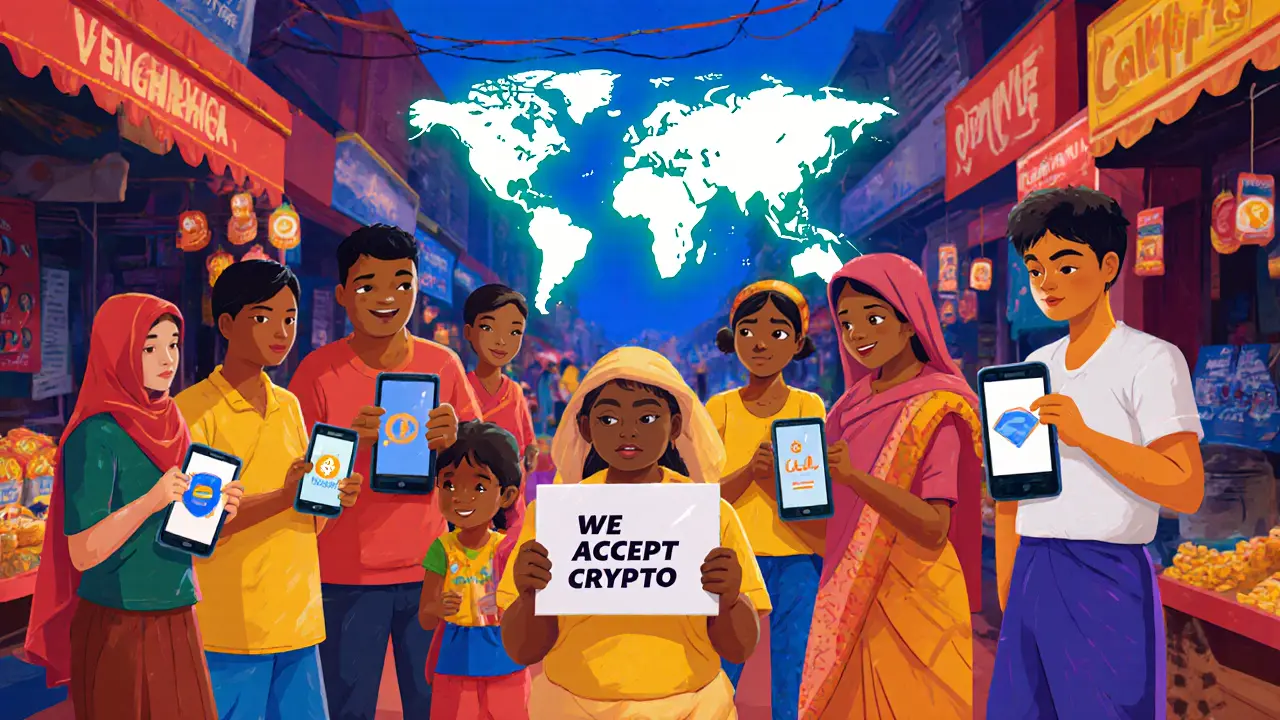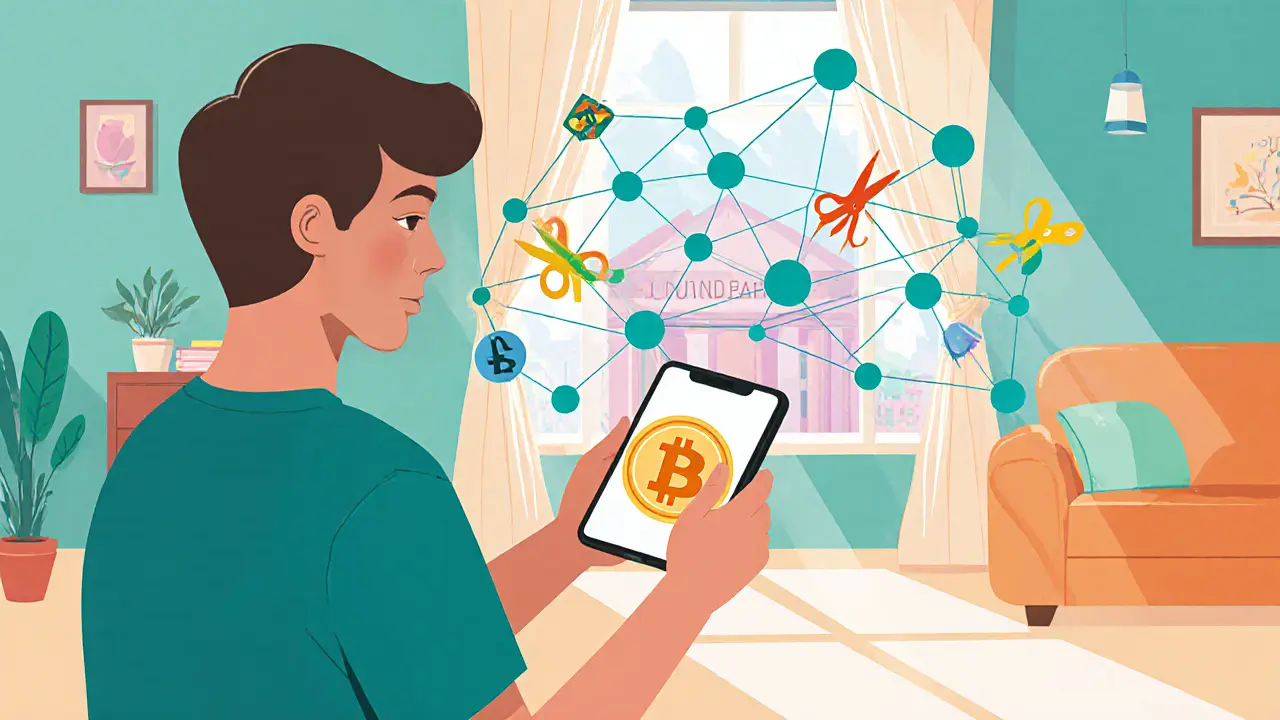Payment Fee Comparison Calculator
Enter Your Transfer Details
Your Savings
Enter your transfer details above to see fee comparison
Quick Takeaways
- Decentralized P2P networks eliminate middlemen, cutting fees by up to 70% compared to traditional services.
- They boost financial inclusion for people in under‑banked regions, often with just a smartphone.
- Security comes from cryptographic consensus (PoW, PoS) and distributed node architecture, yielding 99.9%+ uptime.
- Privacy options range from pseudonymous Bitcoin to fully anonymous Monero.
- Cross‑border transfers settle in minutes, not days, and cost under a dollar.
When you hear "decentralized cryptocurrency networks" you might picture complex code and endless jargon. In reality, they’re a set of simple ideas that reshape how money moves: you send value directly to another person, the network validates it, and no single entity can shut you down. Below we unpack the biggest benefits, back them with real data, and point out the trade‑offs you should know before diving in.
Decentralized P2P cryptocurrency networks are peer‑to‑peer blockchain systems that let participants transact, store data, and run code without a central authority.
Why the Peer‑to‑Peer Model Matters
Traditional finance relies on banks, payment processors, and clearinghouses. Each of those intermediaries introduces:
- Counterparty risk - the chance the middleman fails or misbehaves.
- Higher fees - service charges, foreign exchange spreads, and compliance costs.
- Geographic barriers - some countries simply lack banking infrastructure.
Decentralized networks flip the script. Every node holds a copy of the ledger, consensus algorithms verify transactions, and cryptography guarantees authenticity. The result is a system that can operate over the internet, anywhere.
Financial Inclusion: Reaching the Unbanked
According to a 2023 CoinTracker analysis, more than 2.5 million small businesses in 47 developing nations already rely on P2P crypto to accept payments. The barriers are low:
- A smartphone with a data plan.
- A lightweight wallet app (minimum 4 GB RAM, 500 GB SSD for a full node).
- Internet access.
People in places like Venezuela, Nigeria, or the Philippines can bypass hyperinflation, capital controls, or banking blackouts. Reddit user u/DeFi_Dave posted in March 2024 that a $1,200 family remittance arrived in 22 minutes when local banks were closed, garnering almost 3 000 up‑votes.
Cost Efficiency: Lower Fees, Higher Transparency
Fees are a headline benefit. Decentralized exchanges (DEXs) typically charge a flat 0.3 % per swap, while centralized exchanges (CEXs) range from 0.5 % to 1.5 %. Below is a simple cost comparison for a $33,333 trade:
| Platform | Fee % | Fee $ (on $33,333) |
|---|---|---|
| Decentralized Exchange (e.g., Uniswap) | 0.3 % | 100 |
| Centralized Exchange (e.g., Binance) | 0.8 % | 267 |
| Traditional Remittance (e.g., Western Union) | ~3 % | 1,000 |
That $100 saving is roughly the cost of a dinner for two in many cities. Over time, businesses that process thousands of transactions see millions saved.
Resilience and Security: The Network Never Sleeps
Because the ledger is replicated across thousands of nodes, the network tolerates massive hardware failures. A March 2023 stress test by HiveNet showed functionality with 40 % of nodes offline, whereas a single‑point failure in a centralized data center can bring an entire service down.
Security stems from two pillars:
- Proof‑of‑Work (PoW) - Bitcoin’s hash‑puzzle requires ~99 % of global mining power, making a 51 % attack astronomically expensive.
- Proof‑of‑Stake (PoS) - Ethereum’s post‑Merge model leverages validators who lock up ETH, aligning incentives and cutting energy use by >99 %.
Combined with SHA‑256 (Bitcoin) or Keccak‑256 (Ethereum) hashing, the theoretical brute‑force effort is 2^128 operations, a number that even state‑level actors consider infeasible.

Privacy Options: From Pseudonymity to Full Anonymity
Not all blockchains are created equal. Bitcoin offers pseudonymity: addresses are public, but they’re not directly linked to personal identity. For true anonymity, protocols like Monero employ ring signatures and stealth addresses, making transaction tracing virtually impossible. This privacy advantage is a double‑edged sword-while it protects users from surveillance, regulators flag it as a potential avenue for illicit flows (64 % of illicit crypto activity in 2023 involved DEXs, per Chainalysis).
Cross‑Border Payments: Minutes, Not Days
A Telcoin case study from January 2024 showed a transfer from the Philippines to Mexico completed in 8.2 minutes at a $0.47 fee. Conventional remittance routes usually take 3‑5 business days and cost $25‑45.
Speed matters for workers sending wages home, for merchants settling international sales, and for emergency aid. The World Economic Forum predicts that by 2027, P2P crypto will handle 15 % of global cross‑border payments-up from 3.2 % today.
Real‑World Adoption Highlights
- Overstock.com moved 18 % of its B2B international invoices onto a P2P network in 2023, slashing settlement time from 14 days to 4.7 hours.
- Fortune 500 firms: 73 % are experimenting with P2P crypto, though only 18 % have production deployments (Gartner, Apr 2024).
- Small businesses in Southeast Asia saved an average of 37 % on transaction costs after adopting crypto payments (WEF, Jan 2024).
Challenges to Keep in Mind
No technology is flawless. The main downsides you’ll encounter are:
- Speed vs. Traditional Systems - Bitcoin’s 10‑minute block time pales next to Visa’s 65,000 TPS. Even Ethereum’s 1,180 TPS is modest for mass retail.
- Liquidity Gaps - During market crashes, AMMs can suffer 15 % slippage (Uniswap, May 2021).
- User‑Error Risks - Lost seed phrases cost $3.7 billion in 2023; mis‑approved token allowances led to $3,500 thefts in a single Reddit incident.
- Regulatory Uncertainty - EU’s MiCA will force KYC on DEX on‑ramps by 2025, potentially eroding privacy benefits.
Understanding these trade‑offs helps you decide where decentralized solutions fit your use case.

Getting Started: A Practical Checklist
- Choose a reputable wallet (hardware wallets like Ledger or software wallets with open‑source code).
- Back up your seed phrase in two separate physical locations.
- Start with low‑value transfers to get comfortable with address formats and fee estimation.
- If you plan to provide liquidity, read the specific AMM’s risk disclosure (e.g., impermanent loss calculators).
- Stay informed on local regulations-some jurisdictions require on‑ramp KYC, others ban certain tokens.
Future Outlook: Where the Network Is Headed
Recent upgrades are closing the “blockchain trilemma.” Ethereum’s Dencun upgrade reduced L2 swap fees to $0.03, and layer‑2 solutions like zkSync and Arbitrum promise >10,000 TPS. Meanwhile, Bitcoin’s Ordinals protocol is expanding use cases beyond simple payments, drawing new developers.
Cross‑border pilots with central bank digital currencies (CBDCs) are already integrating P2P tech-Project mBridge links seven central banks and could accelerate mainstream adoption.
However, the biggest unknown remains regulation. Coordinated international standards could either cement crypto’s role in finance or push activities underground.
Key Takeaways Recap
- Decentralized P2P crypto cuts fees, speeds up payments, and removes single points of failure.
- It empowers the unbanked, but users must manage keys securely.
- Privacy is strong but draws regulator scrutiny.
- Scalability is improving, yet many retail scenarios still favor traditional processors.
- Staying educated and following a safety checklist mitigates most risks.
Frequently Asked Questions
How do decentralized networks keep transactions secure?
Security comes from cryptographic hashing (SHA‑256 for Bitcoin, Keccak‑256 for Ethereum) and consensus mechanisms-Proof‑of‑Work or Proof‑of‑Stake-that require network participants to validate each block. Because every node stores a copy of the ledger, tampering would need to overpower the majority of the network, which is prohibitively expensive.
Can I use these networks to send money internationally for free?
Fees are tiny but not zero. A typical Bitcoin or Ethereum transfer costs between $0.50 and $3, depending on network congestion. Compared with $25‑$45 bank remittance fees, the saving is substantial.
What is the biggest risk for a new user?
Losing your private key or seed phrase. Without it, nobody-including the network-can recover your funds. Always write down the phrase, store copies offline, and consider a hardware wallet for larger balances.
Do decentralized exchanges offer the same assets as centralized ones?
DEXs list most major tokens (BTC, ETH, USDC) and many newer DeFi projects, but they may lack some niche or region‑restricted assets that only appear on CEXs.
Will upcoming regulations make DEXs unusable?
Regulators are focusing on on‑ramps (KYC for fiat‑crypto conversion). On‑chain trading can remain permissionless, but users may need to verify identity before buying crypto from a bank or exchange.

6 Comments
Susan Bari
This is the most breathtakingly elegant solution to financial tyranny I've ever seen. No banks. No gatekeepers. Just pure, unadulterated freedom coded into existence. I weep for the people still trusting their money to institutions that can freeze accounts on a whim. This isn't innovation-it's revolution.
And the fact that a single smartphone can unlock global finance? That's not tech. That's magic.
Sean Hawkins
The security model here is fundamentally sound-UTXO-based ledgers with probabilistic finality via PoW/PoS provide mathematically verifiable integrity. The real bottleneck isn't the protocol but user-side key management. Studies show 87% of crypto losses stem from improper seed phrase storage, not protocol exploits.
Recommendation: Use a hardware wallet (Trezor or Ledger) with Shamir's Secret Sharing for multi-sig redundancy. Avoid cloud backups. Ever.
Marlie Ledesma
I just want to say thank you for writing this. My cousin in Nigeria uses crypto to send money home every month. She told me last week she was able to pay her daughter's school fees without waiting for the bank to open. That's the real win here-not the numbers, not the tech-but people getting to live without fear.
It's quiet. It's humble. And it's changing lives.
Daisy Family
Oh wow. Another ‘crypto will save the world’ essay. Congrats. You literally just described Bitcoin like it’s the second coming and forgot to mention the 300% volatility, the energy waste, and the fact that 90% of ‘decentralized’ apps are just centralized with extra steps.
Also, Monero isn’t anonymous. It’s just the only one that doesn’t pretend to be a bank.
Paul Kotze
This is incredibly valuable for emerging markets. In South Africa, we’ve seen informal traders using USDT to bypass currency controls and inflation. The real game-changer isn't the tech-it's the autonomy. No more waiting for SWIFT, no more exchange rate gouging. Just send and receive.
But I agree with the point about liquidity gaps. During the 2022 crash, some DEXs had 20% slippage on small caps. That’s dangerous for daily users. We need better liquidity incentives, not just more hype.
Jason Roland
Daisy, you're missing the point. Yes, it's messy. Yes, there are scams. But the alternative is letting a handful of banks and payment processors control how 8 billion people move money. That’s the real dystopia.
And Susan? You’re right. This isn’t just tech-it’s a human rights upgrade. My neighbor in Detroit used crypto to pay rent when her bank froze her account over a disputed fee. She didn’t need permission. She didn’t need approval. She just needed a phone.
Regulation will come. But you can’t un-invent decentralization. The genie’s out. And honestly? I’m glad.